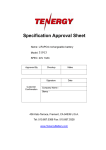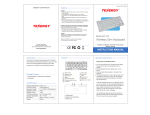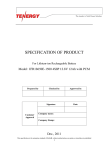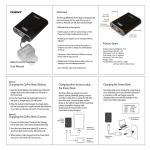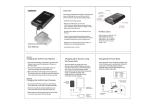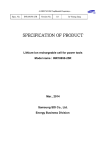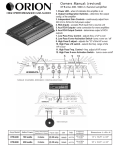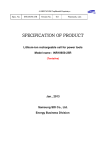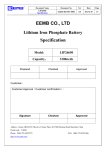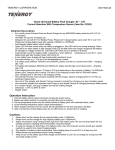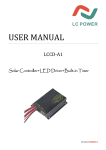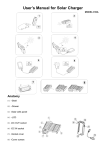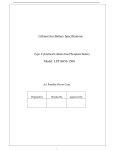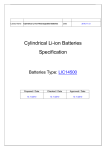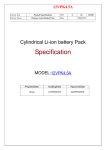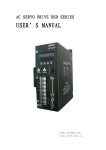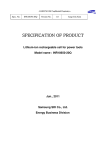Download Specification Approval Sheet - All
Transcript
Specification Approval Sheet Name: LiFePO4 rechargeable battery Model: 26650 SPEC: 3.2V 3300mAh Approved By Customer Confirmation Checkup Make Signature Date Company Name: Stamp: 436 Kato Terrace, Fremont, CA 94539 U.S.A. Tel: 510.687.0388 Fax: 510.687.0328 www.TenergyBattery.com Jul, 2011 Tenergy Corporation 436 Kato Terrace Fremont, CA 94539 Tel: 510.687.0388 Fax: 510.687.0328 www.TenergyBattery.com email: [email protected] History of revision Version Description Date A/0 First issue 2010.7.8 Tenergy Corporation 436 Kato Terrace Fremont, CA 94539 Tel: 510.687.0388 Fax: 510.687.0328 www.TenergyBattery.com email: [email protected] 1. 2. Scope This Product Specification describes the requirements for the rechargeable lithium ion cell ("Cell") to be supplied by Tenergy Corporation Description and Model 2.1. Description Lithium ion rechargeable cell 2.2. Model IFR26650E-3300mAh Note: IFR*26*650* E* 3300= LiFePO4--Li-ion Cylindrical*Diameter*Height*Kind * Capacity 3. Nominal Specifications Items 3.1. Nominal Capacity Specification 3400mAh (Typ.) 3.2. Nominal Voltage 3.2 V 3.3. Charging Voltage 3.65 ±0.05 V 3.4. Charging method CC-CV Constant Current with limited Voltage- Constant Voltage with limited Current (see 7.1) 3.5. Initial Charging Current 3.6. Charging Time Standard Charge : 1650mA Max. Charge : 3300mA Standard Charge : Approx. 4 hours Max. Charge : Approx. 2 hours 9.9A 3.7. Max. Discharge Current(Pulse) 3.8. Discharge Method-Standard 1650 mA 3.9. Max. Continuous Discharge 6.6 A 3.10.Discharge Cut-off Voltage 2.0 V 3.11.Cell Dimension 3.12.Operating Temperature 3.13.Storage Temperature 3.14.Weight 4. 3300mAh (Min.) Outline Dimensions Height Max.66.3mm Diameter Max.26.3mm Charge 5℃ ~ 60℃ Discharge -20℃ ~ 60℃ 1 month -25℃ ~ 45℃ 3 month -25℃ ~ 30℃ 85 ± 2 g Tenergy Corporation 436 Kato Terrace Fremont, CA 94539 Tel: 510.687.0388 Fax: 510.687.0328 www.TenergyBattery.com email: [email protected] See attached drawing (Fig.1). 5. Appearances There shall be no such defect as scratch, flaw, crack, rust, discoloration, leakage, which may adversely affect commercial value of the cell. 6. Reference Standard and Test Conditions This specification is compiled by referring the Standard UL1642、 IEC61960:2003、 UN38.3 GB/T 18287-2000 and so on. Unless otherwise specified, all tests stated in this Product Specification are conducted at temperature 25±5℃ and humidity 65±20 %RH. If it is judged that the test results are not affected by such conditions, the tests may be conducted at temperature 15 ~ 30℃ and humidity 25 ~85%RH. 7. Electrical Characteristics Items 7.1. Standard Charge 7.2. Nominal Capacity 7.3. Cycle Life Test Condition The "Standard Charge" means charging the Cell with initial charge current 1650 mA and with constant voltage 3.65 V ,then constant voltage( 3.65V )with floating current taper to 165mA cut-off (Charger for exclusive use lithium ion rechargeable battery, with an accuracy 3.65+/-0.05V) at 25±5℃ for most 4 hours. The capacity means the discharge capacity of the Cell, which is measured with discharge current 660mA with 2.00 V cut-off at 25±5℃ within 5 hour after the Standard Charge. Each cycle is an interval between the charge (charge current 1650mA) CC 1650mA to 3.65V, CV to 165mA , stop 30min and discharge (discharge current 1650mA) with 2.00 V cut off, stop 30min at 25±5℃.Capacity after 2000 cycles and plus 1 day, measured under the same conditions stated in 7.2. Criteria ≥ 3300mAh ≥80% Nominal capacity 7.4. Internal Impedanc ≤40mΩ Internal resistance measured at 1KHz after Standard Charge. e Charge Current 7.5. Rated capacity 7.6. Charge 1650mA Discharge Current 660mA 1650mA 3.3A 100% ≥95% ≥90% ≥85% Capacity after 28 days storage at 25 ℃ from Standard Charge, measured under the same conditions stated in 7.2. retention 7.7. Cell As of shipment Character Discharge current Retention capacity ≥85% 3.20~ 3.40 (V) voltage 7.8. Discharge 6.6A Discharge Degree No leakage, No Tenergy Corporation 436 Kato Terrace Fremont, CA 94539 Tel: 510.687.0388 Fax: 510.687.0328 www.TenergyBattery.com email: [email protected] 660mA 8. 0℃ 25℃ 60℃ ≥60% ≥80% 100% ≥100% appearance defect Mechanical Characteristics Items 8.1. Drop Test 8.2. Vibration Test 9. -20℃ Test Condition Cell (as of shipment) to be dropped onto the oak-board (thickness ≥20 mm) from 1.2 m height at a random direction, 3 times total at 25±5℃. After standard charging, fixed the cell to vibration table and subjected to vibration cycling that the frequency is to be varied at the rate of 1Hz per minute between 10Hz a 55Hz, the excursion of the vibration is 1.6mm. The cell shall be vibrated for 30 minutes per axis of XYZ axes. Criteria No explosion No fire ,Capacity Recovery ≥90% No explosion No fire ,Capacity Recovery ≥ 90% Safety Characteristics Items 9.1. Impact 9.2. Short Test Condition Criteria A 15.8 mm diameter bar is inlayed into the bottom of a 9.1kg weight. And the weight is to be dropped from a height of 610mm onto a sample battery and then the bar will be across the center of the sample. To short-circuit the Cell charged 3.65 V by connecting positive and negative terminal by 50milli-ohm wire for 1 hour. No explosion, No fire Cells are charge at constant current of 3C5mA and constant voltage of 10V for 2 hour. No explosion, No fire After standard charge .Cells are discharged at constant Current of 0.2C5mA to 2.0V, and the positive and negative terminal is connected by a 30Ω wire for 24 hour. A Steel needle (diameter: 2.5mm-5mm) is Penetrated vertically through the center of a fully charged cell After standard charge ,Cells are heated in a circulating air Oven at a rate of 5℃ per minute to 150℃ and keeping the state for 30 minutes Crush between two flat plates. Applied force is about 13kN(1.72Mpa) for 30min No explosion, No fire No explosion, No fire Circuit 9.3. Over Charge 9.4. Over discharge 9.5. Nail test 9.6. Heating test 9.7. Crush No explosion, No fire No explosion, No fire No explosion, No fire 10. Protection When Li-ion rechargeable battery is used over the permitted voltage or current, electrolyte may disassemble, and this case will affect safety performance of Li-ion rechargeable battery. The parameters of protection circuit module as follows: Overcharge protection voltage 3.950±0.025V Over discharge protection voltage 1.80±0.08V Over current protection ≤ 12.0A (for reference) Tenergy Corporation 436 Kato Terrace Fremont, CA 94539 Tel: 510.687.0388 Fax: 510.687.0328 www.TenergyBattery.com email: [email protected] 11. Product Liability The Safety should be sure to confer previously with between the both parties. The results of the conference must be recorded and the range of the liability or the burden should be cleared. The indications of a warning are established by conference with between the both parties. 12. Shipping The capacity of delivery battery is approximately at 30% of charging. During transportation, keep the battery from acutely vibration, impacting, solarization, drenching. 13. Warranty As long as the Cell is treated in accordance with this Product Specification and / or Handling Precautions and Prohibitions, Supplier warrants that the Cell should be free from any defect for a period of 6 month (25℃ or less) from the date of shipment or for 2000 cycles (see 7.3), whichever comes earlier. The warranty set forth above or described in Handling Precautions and Prohibitions for Lithium Ion Rechargeable Batteries excludes a defect, which is not related to manufacturing of the Cell. 14. Others 14.1.Storage for a long time If Cell is preserved for a long time (more than 3 months); the Cell should be preserved at the dry and low temperature, the cell’s voltage shall be keep at 3.20V~3.40V range. 14.2.Other Any matters that this specification does not cover should be conferred between the both parties. ! Note - When charging the battery, use dedicated chargers and follow the specified conditions. Use the battery only in the specified equipment. Do not connect battery directly to an electric outlet or cigarette lighter charger. Do not heat or throw battery into a fire. Do not use, leave battery close to fire or inside of a car where temperature may be above 60℃. Also do not charge / discharge in such conditions. Do not immerse, throw, and wet battery in water/ seawater. Do not put batteries in your pockets or a bag together with metal objects such as necklaces. Hairpins, coins, or screws. Do not store batteries with such objects. Do not short circuit the (+) and (-) terminals with other metals. Do not place battery in a device with the (+) and (-) in the wrong way around. Do not pierce battery with a sharp object such as a needle. Do not hit with a hammer, step on or throw or drop to cause strong shock. Do not disassemble or modify the battery. Do not solder a battery directly. Do not use a battery with serious scar or deformation. Tenergy Corporation 436 Kato Terrace Fremont, CA 94539 Tel: 510.687.0388 Fax: 510.687.0328 www.TenergyBattery.com email: [email protected] ! Warning - Do not put battery into a microware oven, dryer, or high-pressure container. - Do not use battery with dry cells and other primary batteries, or batteries of a different package, type, or brand. - Stop charging the battery if charging is not completed within the specified time. - Stop using the battery if abnormal heat, odor, discoloration, deformation or abnormal condition is detected During use. Charge. Storage. - Keep away from fire immediately when leakage or foul odor is detected. - If liquid leaks onto your skin or clothes, wash well with fresh water immediately. If liquid leaking from the battery gets into your eyes, do not rub your eyes. Wash them well with clean water and go to see a doctor immediately. ! Caution - Store batteries out of reach of children so that they are not accidentally swallowed. - If younger children use the battery, their guardians should explain the proper handling. - Before using the battery, be sure to read the user’s manual and cautions on handling thoroughly. - Thoroughly read the user’s manual for the charger before charging the battery. - For information on installing and removing from equipment, thoroughly read the user’s manual for the specific equipment. - Batteries have life cycles. If the time that the battery powers equipment becomes much shorter than usual, the battery life is at an end. Replace the battery with a new same one. - Remove a battery whose life cycle has expired from equipment immediately. - When the battery is thrown away, be sure it is non-conducting by applying vinyl tape to the (+) and (-) terminals. - When not using battery for an extended period, remove it from the equipment and store in a place with low humidity and low temperature. - While the battery pack is charged, used and stored, keep it away from objects or materials with static electric charges. - If the terminals of the battery become dirty, wipe with a dry clothe before using the battery. - The battery can be used within the following temperature ranges. Do not exceed these ranges. Charge temperature range: 5℃ to 60℃ Discharge temperature range: -20℃ to 60℃ (When using equipment) Tenergy Corporation 436 Kato Terrace Fremont, CA 94539 Tel: 510.687.0388 Fax: 510.687.0328 www.TenergyBattery.com email: [email protected] Fig.1 Dimension drawing IFR26650E-3300mAh Fig.2 Charge Characteristics (Unit: mm) Fig.3 Cycle life Characteristics Fig.4 Discharge Characteristics








